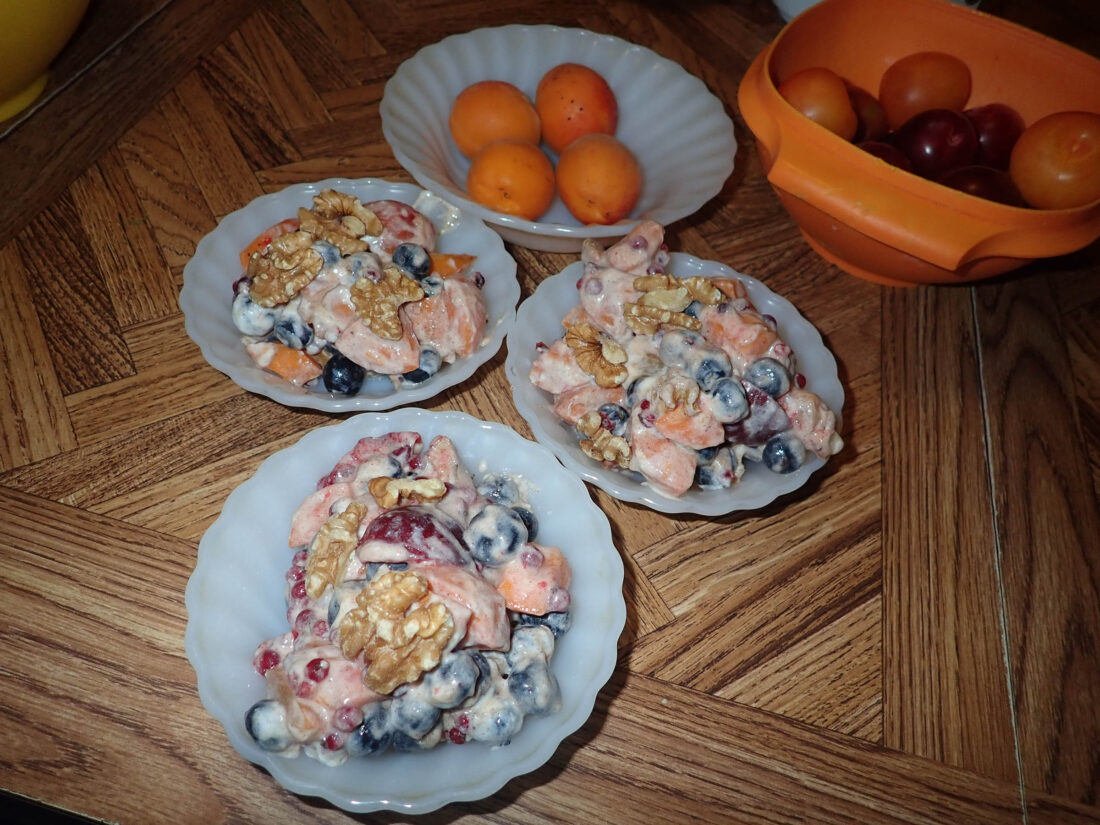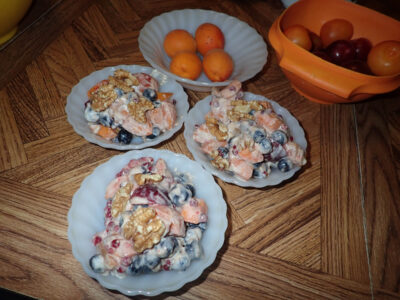Stone fruit: Apricots, peaches, plums

Summertime fruit salad (Provided photo — Yvona Fast)
“An apple is an excellent thing — until you have tried a peach.” — George du Maurier (1834-1896)
One of the highlights of summer are fresh peaches and apricots. They’re aromatic, tender, juicy and sweet — so unlike their counterparts that come shipped from California or even Georgia, which are hard as rocks and rot and become mealy before they ripen. In contrast, when you taste an apricot or peach from a local farm stand, the fragrance and flavor are irresistible as the juice trickles down your chin.
This is because apricots and peaches lose flavor when they travel long distances in refrigerated trucks. That’s why you should buy them as freshly picked as you can. Local peaches and apricots are picked at their peak of sweetness. Those meant for longer transport are picked unripe — often, they will have a greenish tint. Look closely near the stem: it should be creamy yellow, not green. Touch and squeeze; ripe fruit should yield to gentle pressure. But one of the best indicators is the intoxicating fruity perfume.
We don’t have local peaches or apricots in the North Country. But Mapleview Produce brings in apricots, peaches and plums from western New York to our region. For the past three weeks, I bought apricots, peaches and plums grown in Wayne County. Wayne County borders Lake Ontario in the north and the Erie Canal in its southern section. It is west of Oswego and east of Rochester. The area is known for its fruit orchards, and the climate is good for tender stone fruit: cherries, peaches, apricots and plums — so named for their stone-like hard pit.
There are thousands of varieties of plums, ranging in flavor from sweet to tart and in hues from green and yellow to red, orange and all shades of blue and purple. However, only a few grow in New York. Mapleview Produce has brought early yellow and purple plums in the past two weeks.
Plums are the hardiest of stone fruits. European and American plum varieties are hardier than the large, Oriental plums lining the streets of Tokyo with sweet blossoms in February. Oriental plums are susceptible to frost damage, but are very tender and sweet.
Supermarket peaches come from southern states, where they are often picked green and then transported in refrigerated trucks. But even when I’ve brought peaches home from trips to western New York, I have noticed they lose their flavor and become mealy instead of juicy after just a couple of days in my refrigerator.
Americans tend to associate peaches with southern states like Georgia (called the Peach State), but the fruit is native to northern China, where cultivation began around 2000 BCE. There, it is known as the “Tree of the Fairy Fruit,” and is imbued with many mystical qualities: immortality and longevity; fertility and affection; luck, abundance and protection.
Apricots were also first cultivated in northeastern China about 3,000 BCE. From there, they spread west with the Silk Road to the Middle East and southern Europe.
Apricots contain many vitamins (like A and C), minerals (like potassium), antioxidants and lots of fiber. With just 17 calories, they help you stay hydrated, keep your digestive system moving and are beneficial for your heart, skin and eyes.
Like apricots, peaches are low in calories (35 in a medium peach) and packed with potassium and fiber. They are an excellent source of vitamins A, C, E, folic acid and some B vitamins. A little calcium and zinc, as well as many antioxidants and phytonutrients, are also present. Like apricots, they are easily digested. They also help you stay hydrated and are refreshingly thirst-quenching due to their high water content.
Plums are another low-calorie, nutritious and energizing snack. They’re a great source of fiber (especially pectin, a soluble fiber that may help decrease cholesterol), vitamin C, potassium, vitamin A and riboflavin. Their ability to increase iron absorption (probably at least partially related to the high vitamin C content) has been well documented. They are also known for their strong diuretic properties, and, along with other fruits and vegetables, are important in preventing macular degeneration, a leading cause of blindness in adults. They contain unique phenol phytonutrients, neochlorogenic and chlorogenic acid, which help neutralize free radicals in the body.
Eat as many stone fruits as you can now, while they’re fresh. They’re a perfect snack or dessert. In their natural state, no nutrients have been extracted and nothing harmful has been added. If you buy too many, freeze some for making cobblers, crisps and pies in winter, too.
To can or freeze, you will need to peel the fruit. An easy way to do this is to blanch them. Place in a wire basket (like those used for fried foods). Bring a large pot of water to a rolling boil, then dunk the fruit. It will peel easily.
When you’ve had your fill of plain peaches and apricots, try them in ice cream, fruit salad (or add to green salads) or a smoothie.
Fresh Apricot, Peach and Berry Melba
The original Peach Melba was created in 1892 or 1893 by Auguste Escoffier at London’s Savoy Hotel. It combines peaches, berries and ice cream.
–
Ingredients:
–
3 ripe apricots
2 ripe peaches
1 cup blueberries or raspberries, or a combination
1/2 teaspoon orange zest
1 teaspoon honey (optional)
1 Tablespoon raspberry liqueur (optional)
3 to 4 scoops of ice cream (French vanilla or peach)
2 Tablespoons slivered almonds
whipped cream (optional)
–
Directions:
–
Rinse fruit. Quarter, discard pits and place into three serving bowls. To make the sauce, combine berries, honey, zest and liqueur in a saucepan. Heat on low, mashing with a fork until combined, warm and spongy. Top each peach with a scoop of ice cream. Pour warm sauce over, sprinkle with almonds and garnish with whipped cream if desired.
Serves 3.
–
Summertime Fruit Salad
–
Ingredients:
–
3 peaches or 6 apricots
1/2 teaspoon cinnamon
1 or 2 cups berries (blueberries, raspberries, red currants) or cherries (I used blueberries and red currants)
A few plums
1/3 cup slivered almonds or chopped walnuts
1/2 cup sour cream or plain yogurt
1 Tablespoon maple syrup
–
Directions:
–
Pit and dice fruit. Place in a bowl and sprinkle lightly with cinnamon. Add berries and almonds and stir to combine. With a fork or whisk, blend sour cream and maple syrup. Fold into fruit.
Serves 2.
— — —
Author of the award-winning cookbook Garden Gourmet: Fresh & Fabulous Meals from your Garden, CSA or Farmers’ Market, Yvona Fast lives in Lake Clear and has two passions: writing and cooking. She can be found at www.yvonafast.com and reached at yvonawrite@yahoo.com or on Twitter: @yvonawrites.


